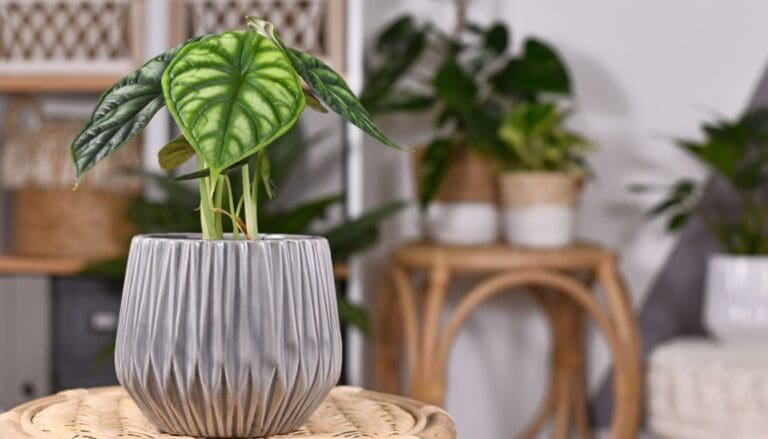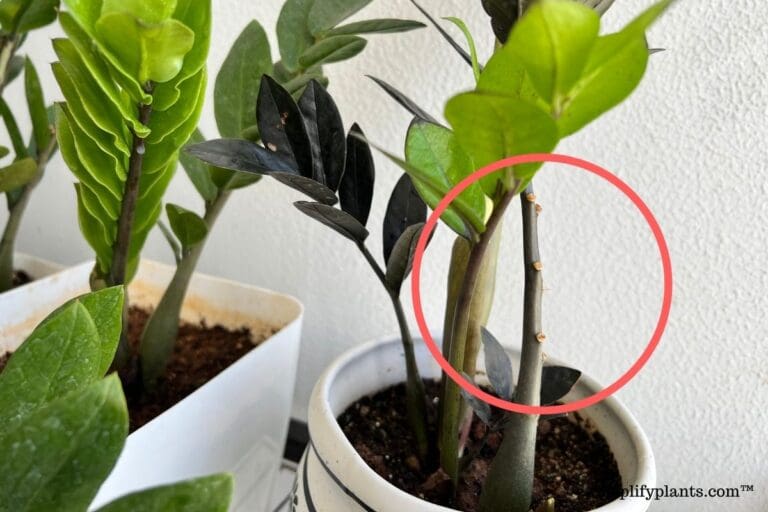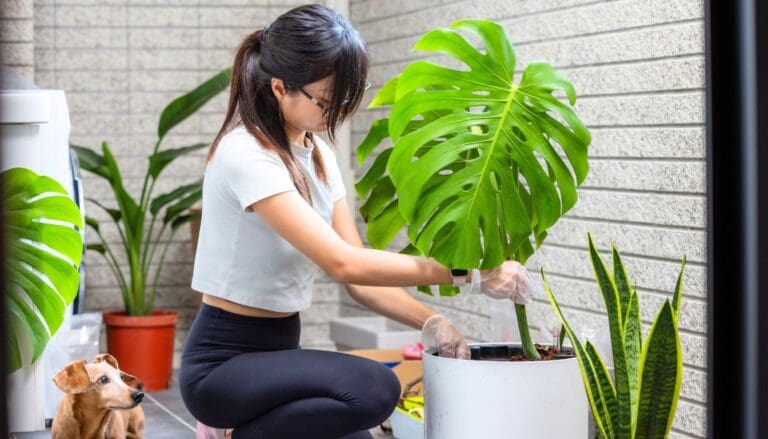Alocasia Sunburn: Signs, Causes & How To Fix
Alocasia is a gorgeous houseplant with large and beautiful arrow-shaped leaves. But their beautiful foliage can get damaged due to various problems, and sunburn is one of them.
Alocasia needs bright indirect sunlight, but exposure to direct sunlight for too long can lead to sunburn. Common signs of sunburn are droopy, brown, and curly leaves. To save the plant from sunburn, place the alocasia where it isn’t exposed to the direct sun.
This article will help you understand every sign and cause behind sunburn in detail and the solutions. You will also learn various preventive measures to protect your alocasia from sunburn.

Please note: Simplify Plants is reader-supported. Some links in the post are affiliate links and I get a commission from purchases made through links in the post.
Signs of a sunburned Alocasia
Signs will help you to identify whether your alocasia is sunburned.
You need to treat your alocasia before it’s too late.
Otherwise, it becomes difficult to revive them, or the plant can die.
Yellow leaves and white patches on alocasia leaves
When alocasia is exposed to direct or intense sunlight, you will see yellow and white patches on the leaves.
The leaves start to dehydrate due to the intense sunlight, which damages the tissues, and therefore, the leaves develop white patches.
Also read: Why Is My Alocasia Turning Yellow? (Causes+Fix)
Brown and brittle alocasia leaves
As time passes, the leaves dry and get brown from the edges.
The brown part expands to every corner, leading to brown and brittle foliage in alocasia.
Brown leaves occur when the plant requires water desperately but stays dehydrated for too long.
Also read: Why Is My Alocasia Turning Brown? (Causes+Fix)
Sunburn often leads to Curly and crispy alocasia leaves
When the leaves stay dry for an extended period, they curl to retain the remaining moisture.
You should immediately treat your plant when you notice signs like the leaves curling, turning dry, brown, crisp, and falling before time.
Otherwise, your alocasia can even die.
Also read: Why Are My Alocasia Leaves Curling? (Causes+How To Fix)
Causes behind sunburn in alocasia
You have to give proper attention to your alocasia if you want it to stay healthy.
The light requirement is one of the main factors, and even a slight mistake can cause extreme stress.
Now let us discuss the causes of sunburn in alocasia.
Overexposure to direct sunlight can burn alocasia leaves.

The most common cause of sunburn is exposing the alocasia to direct sunlight for an extended period.
Most houseplants can’t tolerate direct sunlight as they are very sensitive to it.
Extreme exposure can damage your alocasia.
Alocasia prefers to grow in filtered sunlight, and intense sunlight can damage the cells of the foliage.
When alocasia gets too much sunlight, it destroys the chlorophyll, leading to leaf discoloration.
It destroys chlorophyll and damages necessary photosynthetic pigments that cause various health problems to your alocasia.
Plants mostly suffer from sunburn during the summer when the temperature is high, along with intense sunlight.
Also read: What Kind Of Light Does Alocasia Need? Alocasia Light Requirements
Moving your indoor alocasia plant outside.
When the plants fully adapt to their surroundings, slight changes can stress them.
If your alocasia is growing in moderate indirect sunlight inside your home, sudden exposure to direct light, when moved outside, can shock the plant and cause damage to the leaves.
Extreme shock can damage your alocasia, and the plant can also die.
When the plant stays in the same environment for a longer period, every part of the plant adjusts to these conditions, making it difficult for them to accept the sudden change in the surroundings.
Shifting your alocasia from a comfortable location(indoors) to an area where the plant gets bright direct sunlight(outside) will lead to sunburn.
Sudden exposure to extreme light and heat causes dehydration to the plant, leading to weakness.
This affects the functioning process of alocasia and makes the situation even worse.
How to fix a sunburned Alocasia?

Moving your alocasia suddenly from a shady environment to intense direct sunlight can cause sunburn to the plant.
If you want to fix your plant, you must provide it with ideal care.
You can’t immediately recover your sunburned alocasia, and it takes time.
You have to follow the solutions step by step to fix your plant.
Let us discuss the solutions that you can follow:
- At first, prune all the dry and damaged leaves from alocasia. This will encourage new and healthy growth. Lack of pruning makes the entire plant unhealthy, causing stunted growth.
- Move your alocasia to a shadier spot. This will relieve your plant from sudden stress.
- After the plant recovers, relocate it to the area where it will get indirect sunlight throughout the day.
- The plants lose a lot of leaves due to sunburn, so they need less water. You should reduce watering for some time until the plant develops new leaves. Watering your sunburned alocasia too often can make the situation worse.
- Make sure you don’t stop watering your plant completely. Otherwise, it can cause an underwater situation.
- Don’t fertilize your alocasia when it is sunburned. The plant already stays weak as it loses all of its leaves. Fertilizing it in this situation can harm your alocasia.
- You can continue fertilizing after your alocasia develops new and healthy leaves.
- Try to mist your plant every day to provide some relief. Misting can cool your alocasia to some extent, and it will also prevent the leaves from burning.
- Don’t expose the plant suddenly to a new, bright environment. You should do this gradually. First, place your alocasia into direct sunlight for 1 to 2 hours daily. Continue doing this for 6-7 days to increase the plant’s potential to tolerate the light. After 6-7 days, slowly increase the exposure time for the next few weeks to help your alocasia adjust completely to the direct sunlight.
How to prevent sunburn on alocasia?

It’s better to prevent your alocasia from sunburn than to damage it with extreme exposure.
You can easily prevent your alocasia from sunburn.
You just have to keep some steps in mind.
- Keep your plant in the correct spot
- Apply mulch
- Provide shade
- Give artificial light to the plant
Now let us discuss each point in detail.
Keep your alocasia in the correct spot.
Alocasia requires indirect sunlight to thrive.
The light should not be too low or too intense.
That means you should provide the plant with moderately bright light.
- Don’t keep your plant in a location where the temperature fluctuates frequently.
- Avoid keeping alocasia near a heater, chimney, furnace, or radiator. This can dry your plant to an extreme level.
- You should always provide shade to your plant to protect it from direct sun rays.
- You can cover the windows with curtains to protect them.
- Keep your alocasia near an east or north-facing window to avoid direct sunlight.
- The light in these directions is not harsh. Keep your plant at least 6-7 feet away from the window to prevent sunburn.
Mulching
If giving proper shade is impossible, you can mulch the soil surface.
You can use shredded bark, tree leaves, wheat straws, or compost for mulching your alocasia.
Mulching can help your plant to stay moisturized even in summer.
The evaporation rate slows down, so the plant stays hydrated for an extended period.
Mulch keeps the plant moisturized and protects the soil surface from the direct sun rays.
This is one of the best ways to prevent sunburn in your plant.
Provide shade to the alocasia.
You need to provide shade to your alocasia if it is in an outdoor setting to protect it from harsh light.
You can use a shade net to protect against sunlight and direct heat.
You can easily get this from any market.
You can also use sheer curtains, fabric cloth, frames, and hoops to provide shade.
While choosing any shade, make sure the plant can breathe into it; otherwise, it can suffocate.
Provide artificial light to the alocasia.
If it gets difficult for you to provide indirect sunlight without exposing the alocasia to direct sunlight, there is a solution.
When the sun gets too harsh for your plant, you can provide it with artificial light.
Artificial light works like natural sunlight, so you can continue it for some days.
You can again relocate your plant near a window when the sunlight becomes less intense and tolerable for alocasia.
Care tips for alocasia

| Factor | Care Tips |
|---|---|
| Light | Alocasia needs at least 6-8 hours of indirect sunlight every day. If they don’t get enough, they can suffer from health issues like leggy growth and smaller leaves. Use artificial light to provide enough light. Protect the Alocasia from direct sunlight. |
| Water | Alocasia needs at least 6-8 hours of indirect sunlight every day. If they don’t get enough, they can suffer from health issues like leggy growth and smaller leaves. Use artificial light to provide enough light. Protect the alocasia from direct sunlight. |
| Humidity | Alocasia needs at least 6-8 hours of indirect sunlight every day. If they don’t get enough, they can suffer from health issues like leggy growth and smaller leaves. Use artificial light to provide enough light. Protect the alocasia from direct sunlight. |
| Temperature | Alocasia thrives in warm temperatures between 65-85°F. Try to maintain the temperature by using a thermostat device. Don’t keep your plant near frosty windows, hot or cold drafts, air conditioners, heaters, radiators, or any cool or hot object. Also, avoid keeping the plant near a window or door that is frequently opened and closed. Sudden temperature fluctuations can also cause the same trouble. |
| Soil | Alocasia thrives in warm temperatures between 65-85°F. Try to maintain the temperature by using a thermostat device. Don’t keep your plant near frosty windows, hot or cold drafts, air conditioners, heaters or radiators, or any cool or hot object. Also, avoid keeping the plant near a window or door that is frequently opened and closed. Sudden temperature fluctuations can also cause the same trouble. |
| Fertilizer | Alocasia likes to grow in well-drained soil that also retains enough moisture. Use a soil mix that contains equal parts of regular potting soil, perlite, and peat moss. Make sure you don’t change the soil frequently. Otherwise, it can stress your plant. To improve the soil texture, you can simply blend it with manure or compost. |
| Pruning | Always prune all the damaged parts of the plant to encourage new and healthy growth. If you notice overgrowth, dry and diseased leaves, leggy growth, and dead branches, cut them off. Use a sterilized scissor and make a sharp cut. |
Final words
Intense and direct sunlight doesn’t suit Alocasias and can easily cause sunburn. If you notice that the plant is sunburned, relocate it to a shadier location and prune all the damaged leaves, as they will not turn healthy again.
Don’t provide too much sunlight until your alocasia recovers fully. Provide some water to the plant and allow it to recover. After recovery, you can continue to provide your alocasia with bright indirect sunlight.
If you want to expose your alocasia to direct sunlight or move it outside, do it gradually to avoid sunburn. However, alocasia will do best when placed under indirect sunlight.

Reference: Alocasia sanderiana, Alocasia micholitziana.
Recommended Garden Supplies
| Product Image | Our Recommended Gardening Supplies | Check Offers! |
|---|---|---|
Top Top
Top
Top
Top
Top
Top
Top
Top | rePotme Houseplant and Tropical Classic Potting Soil Mix | Check Offer On Amazon |
 Top
Top
Top
Top
Top
Top
Top
Top | Espoma Organic Indoor Plant Food | Check Offer On Amazon |
 Top
Top
Top
Top
Top
Top
Top
Top | GooingTop LED Grow Light 6000K Full Spectrum Clip Plant Growing Lamp | Check Offer On Amazon |
 Top
Top
Top
Top
Top
Top
Top
Top | Soil Moisture Meter | Check Offer On Amazon |
 Top
Top
Top
Top
Top
Top
Top
Top | Govee Hygrometer Thermometer, Bluetooth Enabled! | Check Offer On Amazon |
 Top
Top | LEVOIT Humidifiers for Large Room(Best For Plants) | Check Offer On Amazon |
 Top
Top
Top
Top
Top
Top
Top
Top | Upgraded DIY Automatic Drip Irrigation Kit, 15 Potted Houseplants Support | Check Offer On Amazon |
 Top
Top
Top
Top
Top
Top
Top
Top | Stainless Steel Heavy Duty Gardening Tool Set | Check Offer On Amazon |
 Top
Top
Top
Top
Top
Top
Top
Top | Bonide Insecticidal Soap | Check Offer On Amazon |
 Top
Top
Top
Top
Top
Top
Top
Top | Bonide 32 oz Spray Neem Oil for Organic Gardening | Check Offer On Amazon |
 Top
Top
Top
Top
Top
Top
Top
Top | Garden Safe Fungicide | Check Offer On Amazon |






